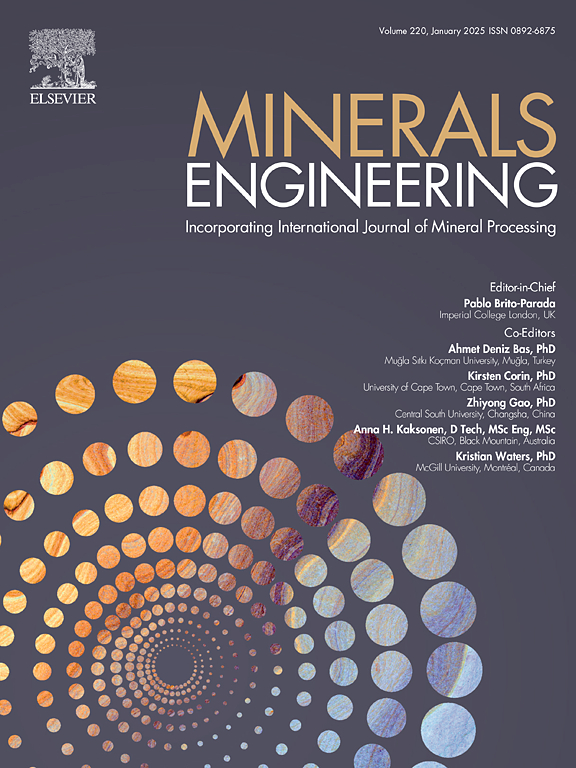Improving copper sulfides liberation using pulse power comminution (PPC). Application to Escondida hard ore deposit
IF 4.9
2区 工程技术
Q1 ENGINEERING, CHEMICAL
引用次数: 0
Abstract
High Pulse Power (HPP) has been developed for mining applications (comminution) in the late 70s-early 80s (Andres., 1989). The main principle of HPP is compressing a slowly stored energy (ms-s) that is delivered quickly (<10 µs) in order generate a peak of electric power. This later is then transmitted in a media chamber to create an electric arc and shockwaves that pulverize rocks. Based on these assumptions, using I-ROX HPP technologies, different experimental procedures (PPC) have been developed to investigate the selective liberation of copper sulfides minerals from Escondida hard ore deposit (partnership with BHP) using SEM automated mineralogy (SEM-MLA-AMICS). Results have been compared with conventional comminution (CC) (crushing (C-for coarse) and grinding (F- for fine)) and with initial texture of the deposit. In all PPC experiments, liberation in coarser sizes is better than in CC. During coarse crushing, a stronger Cu enrichment is observed in the fine particles created by PPC than that by CC. Other results from fine grinding show that overgrinding can be prevented, resulting in better liberation in the floatable sizes. Overall, results show 10 % increase of highly liberated particles in F-PPC compared to F-CC, most likely implying that copper recovery after rougher flotation could be equivalent/better to CC at bigger/similar particle size, respectively.
利用脉冲功率粉碎(PPC)提高硫化铜析出率。应用于埃斯康迪达硬矿床
高脉冲功率(HPP)在70年代末至80年代初被开发用于采矿应用(粉碎)。, 1989)。HPP的主要原理是压缩缓慢储存的能量(ms-s),并快速传递(<10µs),以产生峰值电力。然后在介质室中传输,产生电弧和冲击波,粉碎岩石。基于这些假设,利用I-ROX HPP技术,开发了不同的实验程序(PPC),利用SEM自动化矿物学(SEM- mla - amics)研究Escondida硬矿床中铜硫化物矿物的选择性释放(与必和必拓合作)。结果已与常规粉碎(CC)(破碎(c为粗)和研磨(F-为细))和沉积物的初始织构进行了比较。在所有的PPC实验中,较粗粒度的解离效果优于CC,在粗破碎过程中,PPC产生的细颗粒比CC产生的细颗粒更富集Cu,细磨的其他结果表明,PPC可以防止过磨,从而使可浮选粒度的解离效果更好。结果表明,与F-CC相比,F-PPC中的高游离颗粒增加了10%,这很可能意味着粗浮选后的铜回收率在较大/相近粒度下分别相当于/优于CC。
本文章由计算机程序翻译,如有差异,请以英文原文为准。
求助全文
约1分钟内获得全文
求助全文
来源期刊

Minerals Engineering
工程技术-工程:化工
CiteScore
8.70
自引率
18.80%
发文量
519
审稿时长
81 days
期刊介绍:
The purpose of the journal is to provide for the rapid publication of topical papers featuring the latest developments in the allied fields of mineral processing and extractive metallurgy. Its wide ranging coverage of research and practical (operating) topics includes physical separation methods, such as comminution, flotation concentration and dewatering, chemical methods such as bio-, hydro-, and electro-metallurgy, analytical techniques, process control, simulation and instrumentation, and mineralogical aspects of processing. Environmental issues, particularly those pertaining to sustainable development, will also be strongly covered.
 求助内容:
求助内容: 应助结果提醒方式:
应助结果提醒方式:


